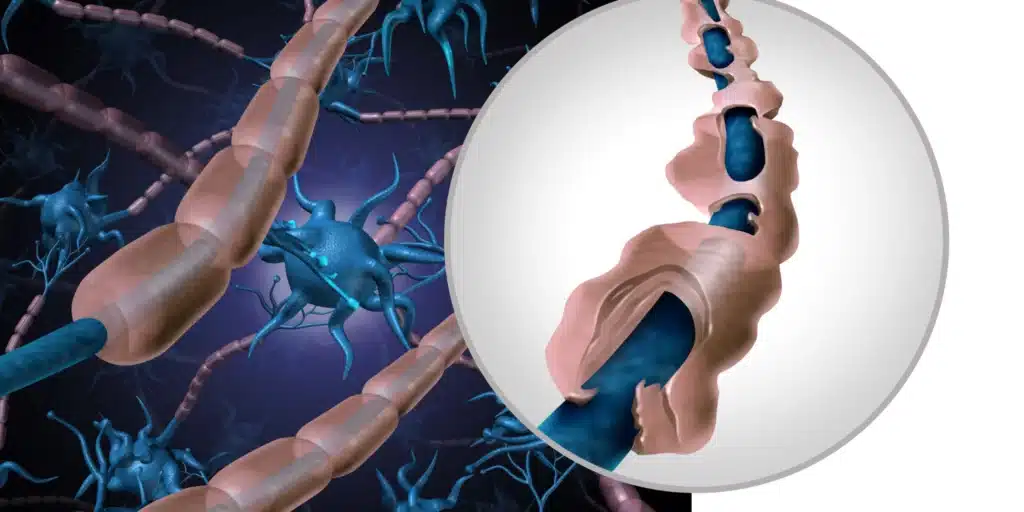|
Getting your Trinity Audio player ready...
|
Blog Summary:
In this blog post about multiple sclerosis, you will learn about the development and symptoms of MS as well as discover life-changing advice from medical experts like Terry Wahls, MD, about how to manage and potentially reverse the symptoms of multiple sclerosis. In 2021, Dr. Wahls published a clinical trial finding that a modified Paleolithic elimination diet (The Wahls Diet) reduces fatigue and improves quality of life.
What is Multiple Sclerosis?
Shock-like pain, difficulty thinking, and becoming easily fatigued. These are some of the extreme symptoms people with multiple sclerosis experience and hope to reverse.
Multiple sclerosis (MS) affects nearly 3 million people worldwide. It is a chronic, progressive disease that damages your nerves and steals your independence.
Multiple sclerosis was reported to be one of the leading causes of disability in young adults in the United States. It is also reported to be 3.5 times more likely to occur in women.
Over time, MS causes you to lose your ability to move, communicate, and think clearly. That is not to mention the severe, unpredictable pain that can suddenly occur.
These physical and emotional challenges due to MS cause many with it to feel fear and anxiety about the future.
If you want to better understand a day in the life of someone with MS, you can learn from these stories.
Although there is no cure, many advances have been made that allow people with MS to live their best possible lives. Terry Wahls, MD, is one physician who has made significant discoveries regarding how to treat MS.
You will learn about the development and symptoms of MS as well as discover life-changing advice from medical experts like Terry Wahls, MD, about how to manage and potentially reverse the symptoms of multiple sclerosis.
What Causes Multiple Sclerosis?
The causes of MS are not clear. We do know that the immune system becomes dysregulated and begins to attack your nerves, which causes MS to progress.
Environmental and genetic factors could increase your risk of developing MS. One study summarized that the primary risk factors are:
· Female sex at birth
· Caucasian ethnicity
· Epstein-Barr virus infection
· Genetic mutations of:
o Major Histocompatibility Complex
o Interleukin-2 Receptor Alpha
o Interleukin-7 Receptor Alpha
· Cigarette smoking
· Low Vitamin D
· Lack of sun
Regarding genetic factors, the mutations listed appear to be strongly linked risk factors. Also, if a first-degree relative has MS, you are between 10 and 50 times more likely to develop MS, according to one study.
The Epstein-Barr virus is reported to increase the risk of MS by 15 times if infected in childhood and by 30 times if infected in adolescence or adulthood.
Cigarette smoking increases your chance of developing MS by 50%. Low vitamin D and a lack of sun may also be risk factors, but more research is needed to understand how these are linked to MS.
As multiple sclerosis progresses, the Mayo Clinic states that you may experience symptoms like:
· Muscle weakness
· Electric shock like pain
· Muscle spasms and stiffness
· Mental health changes
· Difficulty thinking and communicating
· Inability to control your bladder and bowels
· Reduced sensations
· Loss of vision
· Loss of coordination and balance
There are different courses that MS can take. It is nearly impossible to predict how quickly MS will progress. It can progress extremely quickly or be inactive for months and then attack unexpectedly.

The Different Courses of MS
According to the National MS Society there are four main courses of MS progression:
1. Clinically Isolated Syndrome
2. Relapsing-remitting MS
3. Secondary progressive MS
4. Primary progressive MS
Clinically Isolated Syndrome
Clinically isolated syndrome refers to the first experience of neurologic symptoms listed above. The symptoms must last for 24 hours or more. They must be caused by central nervous system inflammation and demyelination. If you have more than one neurological event that meets these criteria, you will be diagnosed with multiple sclerosis.
It is possible that only one such event can occur in someone’s lifetime. But it is unlikely.
The National MS Society reports that your MS risk is high if brain lesions appear in an MRI after a neurologic event. One review indicates that 50-70% patients experiencing clinically isolated syndrome will have demyelinating lesions.
Within 20 years, up to nearly 70% of those patients could develop MS, according to one report.

- Access the Reverse Multiple Sclerosis and Neuroimmune Disorders Summit
Learn from top leaders in the field the skills you need today.
Relapsing-remitting MS
The most common course of MS is relapsing-remitting MS. It is found in approximately 85% of patients with MS.
With relapsing-remitting MS, “relapse” events occur and cause neurological symptoms at unpredictable times. Patients with relapsing-remitting MS could experience relapse episodes at least once a year. They may also experience progressively more brain lesions and subsequent disability.
After a relapse event, MS symptoms could return to pre-event levels. However, one report indicated that nearly half of all relapse episodes can cause worsening of disability or long-term symptoms.
Secondary Progressive MS
If people with relapsing-remitting MS do not receive treatment, a majority of them will develop secondary progressive MS, according to one review.
In secondary progressive MS, neurologic symptoms may constantly be present and cause progressively more disabling symptoms. Importantly, there could be worsening of the disability without relapse events in this course, unlike relapsing-remitting MS.
Primary Progressive MS
In primary progressive MS, approximately 10-20% of patients develop primary progressive MS, according to one report.
In this course, there is no event of relapsing-remitting MS, the disease has ongoing progression from the start. Progression may not be consistent, and it may even slow or stop at times.
How Does Multiple Sclerosis Progress?
Simply put, MS symptoms progress when the immune system damages the nerves in your brain and spinal cord.
The symptoms of multiple sclerosis begin when the protective coverings of the nerves known as “myelin” are damaged by immune cells and inflammation. This process is demyelination and causes the volume of myelin to decrease. Multiple sclerosis is the most common demyelinating disease.
So, what is demyelination and how does it happen?
For your nerves to work effectively, they need myelin for protection and insulation. Myelin allows your nerves to function efficiently by insulating the electric signals that nerves produce. From getting out of bed to running a marathon, you need good myelin health to perform any action.
According to this review, demyelination refers to damage to or breakdown of the myelin on your nerves.
In MS, certain immune system cells like CD8+ T cells become autoreactive. This means that these cells will target your own tissues and break them down. In the case of MS, nerves in the central nervous system are the primary targets. In some courses of MS, myelin breakdown occurs slowly and consistently. In others, “relapses” or “attacks” occur at unpredictable times, which can cause new levels of disability.
The Mayo Clinic reports that when demyelination occurs, your nerves’ electrical signals can slow down or even stop.
Despite the unpredictability of this disease, there are lifestyle modifications that you can make to potentially reverse multiple sclerosis symptoms.

How to Manage Multiple Sclerosis Symptoms at Home
Multiple sclerosis is difficult to manage, but medical research has been identifying ways that you can take action to improve your MS symptoms at home with lifestyle modification.
Please note that the recommendations are NOT alternatives to your medical treatment plan. Be sure to consult your physician before trying any lifestyle modifications. The Mayo Clinic reports that there are many medical treatments like medications, antibodies, and others that may improve symptoms in people with MS.
The key, at home factor within your control that can improve MS symptoms is diet.
Diet has been reported to significantly affect fatigue and quality of life in MS. Terry Wahls, MD, is a leading medical researcher on how diet could improve MS symptoms.
Dr. Wahls is living proof that symptoms of multiple sclerosis can be reversed. In one video, she stated, “I descended into disability… I was in the zero-gravity chair or in bed.” In “The Seventy Percent Solution”, she stated that she can now bike 18 miles and ride horses in the Canadian Rockies.
So, what is her secret to reversing MS?
The Wahls Diet Explained
Food is the key to living a healthy life. It is also a way for toxins and allergens to wreak havoc on our minds and bodies.
Dr. Wahls discussed in her article “The Seventy Percent Solution” that food allergies and toxic load can cause physical, neural, and psychological issues. This was a starting point for her to develop an MS-specific diet. You can learn more about how she developed the diet here.
Now, she continues to research, and recently, she reported incredible findings.
In 2021, Dr. Wahls published a clinical trial finding that a modified Paleolithic elimination diet (The Wahls Diet) reduces fatigue and improves quality of life.
According to this study, 12 and 24 weeks of the Wahls Diet reduced fatigue, improved physical quality of life, and improved mental quality of life.
The Wahls Diet recommendations for daily consumption are as follows:
· 2-3+ cups of dark green leafy vegetables
· 2-3+ cups of sulfur-rich vegetables
· 2-3+ cups deeply colored fruits and vegetables
· 4oz nuts maximum
· 6-12 oz meat/fish
· 30g unsaturated fats maximum
· 1 serving seaweed
· 1 serving algae
· 1 serving nutritional yeast
· 1 serving fermented food
As important as it is to consume the right foods, it is equally important to avoid foods that will make symptoms worse. It is recommended that people with MS avoid:
· Eggs
· Legumes
· Dairy
· Trans fats
Lastly, it is essential to get the correct supplements. Each day, the Wahls Diet recommends:
· 1 multivitamin
· 1000 mcg methylfolate
· 1000 mcg methyl B12
· 5000 IU (125 mcg) Vitamin D3
· 1 teaspoon cod liver oil
It is clear to see that you can take control of your diet to improve and potentially reverse multiple sclerosis symptoms.
It is important to know that changing your behavior can take time. Consistently taking a small step each day could help you reverse MS and improve your quality of life.
To learn more, you can register for the multiple sclerosis and neuroimmune summit for free!
About the Author
Daniel Chantigian, MS, is exploring many chronic diseases, you can explore his works here.
Multiple sclerosis References
- Garg, N., & Smith, T. W. (2015). An update on immunopathogenesis, diagnosis, and treatment of multiple sclerosis. Brain and behavior, 5(9), e00362. Read it here.
- Harbo, H. F., Gold, R., & Tintoré, M. (2013). Sex and gender issues in multiple sclerosis. Therapeutic advances in neurological disorders, 6(4), 237–248. Read it here.
- Weinshenker B. G. (1996). Epidemiology of multiple sclerosis. Neurologic clinics, 14(2), 291–308. Read it here.
- National Multiple Sclerosis Society. “Types of MS.” National Multiple Sclerosis Society, 2013. Read it here.
- National Multiple sclerosis society. “Clinically Isolated Syndrome (CIS).” National Multiple Sclerosis Society, 2017. Read it here.
- Klineova, S., & Lublin, F. D. (2018). Clinical Course of Multiple Sclerosis. Cold Spring Harbor perspectives in medicine, 8(9), a028928. Read it here.
- Miller, D. H., Chard, D. T., & Ciccarelli, O. (2012). Clinically isolated syndromes. The Lancet. Neurology, 11(2), 157–169. Read it here.
- Lublin, F. D., Baier, M., & Cutter, G. (2003). Effect of relapses on development of residual deficit in multiple sclerosis. Neurology, 61(11), 1528–1532. Read it here.
- Ransohoff, R. M., Hafler, D. A., & Lucchinetti, C. F. (2015). Multiple sclerosis-a quiet revolution. Nature reviews. Neurology, 11(3), 134–142. Read it here.
- Leray, E., Moreau, T., Fromont, A., & Edan, G. (2016). Epidemiology of multiple sclerosis. Revue neurologique, 172(1), 3–13. Read it here.
- Lubetzki, C., & Stankoff, B. (2014). Demyelination in multiple sclerosis. Handbook of clinical neurology, 122, 89–99. Read it here.
- Swanson, Jerry. “Find out More about Demylinating Disease like Multiple Sclerosis.” Mayo Clinic, 2017. Read it here.
- Mayo Clinic. “Multiple Sclerosis.” Mayoclinic.org, 7 Jan. 2022. Read it here.
- Wahls, T. L., Titcomb, T. J., Bisht, B., Eyck, P. T., Rubenstein, L. M., Carr, L. J., Darling, W. G., Hoth, K. F., Kamholz, J., & Snetselaar, L. G. (2021). Impact of the Swank and Wahls elimination dietary interventions on fatigue and quality of life in relapsing-remitting multiple sclerosis: The WAVES randomized parallel-arm clinical trial. Multiple sclerosis journal – experimental, translational and clinical, 7(3), 20552173211035399. Read it here.
- Wahls T. L. (2011). The seventy percent solution. Journal of general internal medicine, 26(10), 1215–1216. Read it here.
- Wahls, T. L., Chenard, C. A., & Snetselaar, L. G. (2019). Review of Two Popular Eating Plans within the Multiple Sclerosis Community: Low Saturated Fat and Modified Paleolithic. Nutrients, 11(2), 352. Read it here.





